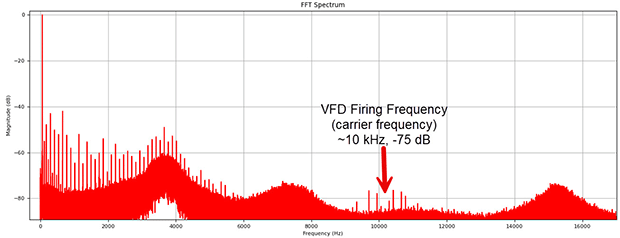During the CIGRE Grid of the Future symposium and workshop, harmonics were recognized as a critical focus in modern electrical systems, where high-frequency switching technologies and inverter-based resources dominate power generation, distribution, and commercial and industrial facilities.
This article examines the causes, effects, and some mitigation strategies for harmonics, emphasizing high-order harmonics (>100X) and even-order harmonics. We explore impacts across grids, distribution systems, commercial/industrial setups, and grounding systems, offering insights into power quality degradation, efficiency losses (energy & emissions), and system safety.
Harmonics in electrical systems are distortions in current and voltage waveforms caused by non-linear loads, switching devices, and inverter-based resources (IBRs).
While we tend to be focused, including in most standards, on the ‘common’ low-end harmonics such as 3rd, 5th, 7th and their multiples, we often hear people try to state that even harmonics, interharmonics and high-order harmonics (i.e.,>63rdand often >101st) are not an issue.
With the prevalence of fast switching systems in the 1990s and increasing customer loads, especially data centers and large variable frequency drives, new failures that emulate older failures are rising, such as bearing fluting even with shaft brushes.
On the power generation side, these harmonics are now present within the grid with the slowly increasing adoption of HVDC (High Voltage Direct Current) distribution systems and inverters used in wind, solar, energy storage, and other IBR.
Understanding High-Order Harmonics: Beyond Traditional Power Quality Issues
These ‘new’ harmonics, coupled with traditionally understood values, exacerbate power quality issues, disrupt operations, and damage infrastructure. This includes degradation of grounding systems, safety relay problems, degradation of cable insulation systems, noise in communications due to skin effect and electromagnetic induction (EMI), mechanical component degradation, and more.
IEEE 519, “IEEE Recommended Practice and Requirements for Harmonic Control in Electric Power Systems,” presently defines harmonics as integer multiples of the line frequency (i.e., 50 or 60 Hz) and interharmonics as non-integer multiples of the line frequency.
The tables within the standards stop at the 50th order. The primary limits were set based on flicker, which is based upon an incandescent bulb, and impact on a rotating machine, such as the 5th harmonic generating a counter-rotating field and the 7th generating a pro-rotating field in a machine airgap.
IEC 61000-4-30, “Testing and Measurement Techniques – Power Quality Measurement Methods,” also covers harmonics to the 50th. However, Annex C, ‘Conducted emissions in the 2 kHz to 150 kHz range,’ was added in the 2021 edition. This standard primarily covers how to take measurements with instrumentation to see the harmonics in these ranges.
These harmonics are referred to as Supra-Harmonics and have a tremendous effect on capacitors, telecommunication interruption, wireless communication disturbances, and increased error in measurement equipment.
There are additional considerations for supra-harmonics, which we find with ESA/MCSA systems that read above 10 kHz sampling, in which the high frequencies include high impedances in shaft current brushes, resulting in bearing damage.
Local Impact of Supra-Harmonics
Utilities have started addressing supra-harmonics, which was the topic of several discussions at the CIGRE Grid of the Future conference. What impact does that have on us? Let’s take a closer look at what we have going on in our own systems.
One of the problems with showing supra-harmonics as a concern is that the values appear to be very low in absolute numbers. The values will appear deceptively low even when shown as a %THD or TDD (Total Harmonic Distortion – voltage, or Total Dynamic Distortion – current). This is one of the reasons why our research group looks at these in -dB, which is a relative ‘force’ relationship.
Figure 1 shows an electric motor on a VFD with the carrier frequency set to ~10 kHz. The investigation was initiated based on bearing fluting even with shaft grounding brushes. In Figure 2, we look closer at the values of 10,177 Hz with multiple sidebands of 2X line frequency. 10,177 Hz at 60 Hz is the ~170th harmonic in.
This high frequency will generate a high impedance through different brush materials but will allow current to flow more easily across the bearing lubrication. This also has the effect of degrading the lubrication and causing it to change color (darken) as current passes through it, causing carbonization.

Figure 1: Motor on a VFD set at 10 kHz firing frequency. Data was collected with an EMPOWER MCSA.

Figure 2: Zoomed spectra to the firing frequency and 2xLF Sidebands with peaks at ~-76 dB.
The impact of these frequencies and other frequencies in the electrical system can result in many power frequencies that will be seen as multiple harmonics to higher frequencies. The motor next to the one in Figures 1 and 2 operates across the line. Because of the inverter systems nearby, the current spectra appear as in Figure 3.

Figure 3: Power harmonics in dB across the spectra out to 22 kHz appear to die out at 12 kHz.
While the values, in this case, the values are pretty low, we have observed much higher noise floors and frequencies. However, all these motors, including the ones not on VFDs, had problems with bearing fluting, even with a shaft grounding system.
In fact, we are seeing an increasing number of faults while observing disconnected protection systems, as high-frequency noise is found in grounding systems.
An Electric Motor At 2 kHz Carrier Frequency
What happens if we review a motor at a low carrier frequency, such as 2 kHz, which is common in most industrial applications and commercial systems not associated with HVAC? When the drive is not set correctly, we can get an extremely interesting result, as shown in Figure 4. In this case, the frequencies extending beyond the 2 kHz values have harmonics of the carrier frequency.

Figure 4: Current spectra showing carrier frequency high-order harmonics across 22 kHz.
Effects On Lighting Systems
We are finding that these problems are not limited to power systems but to lighting systems. For instance, Figure 4 shows a neutral current on a newly installed LED system that replaced a fluorescent lighting system as part of an energy upgrade.

Figure 5: Neutral current collected from a lighting panel. The neutral current measurement was >150 Amps due to circuit unbalance of the loads and high harmonics on the power side.
What is interesting about Figure 4 is that the high-frequency noise at exactly 12 kHz is measured as 0 dB, which means that the peaks have relatively the same ‘force’ as at 60 Hz. This high frequency and exceptionally high neutral current dramatically affects the supply transformer and grounding systems.
When we see values like this, a study we have been involved with since 2021, we will see corresponding high energy present in the ground, including harmonics that, according to standards, should not exist.
Effects On Transformers
These high-order harmonics, as well as normal power harmonics, impact transformers. When a transformer is loaded, the resulting harmonics generate core resonances. This can be from power harmonics or neutral and ground harmonic content.
The result of this condition will be even harmonics. In the case of Figure 5, the transformer is loaded in addition to harmonic conditions with the data collected on the utility side of the meter. Note the current waveform, which results from electronic equipment and VFDs in the facility.

Figure 6: Transformer rated 13,800 Volt on the primary, showing low level even and odd harmonics in current and odd harmonics in voltage—data collected with an EMPATH ESA system.
In the past, our focus has been on regular power harmonics. As expressed at the CIGRE Grid of the Future symposium, high-order harmonics running from 2 kHz to 150 kHz are becoming a problem in the grid, local distribution, and end customers.
These high-order harmonics impact a facility’s electrical and mechanical systems, in addition to EMI interference in communications and other systems. The resulting high-order harmonics will also be found in neutral and grounding systems, which can generate resonance and heating in transformer cores.
Similar conditions exist in the bulk grid, which sees these conditions on a larger scale from HVDC transmission systems, IBRs, and data centers. With data centers expected to exceed 25% of the total load from the present >5% load by 2040, it is urgent that the problem is resolved.
This may include necessary changes to how the grid manages end use, including penalties for harmonic conditions and supra-harmonics similar to the power factor.
These conditions can be filtered out in power, neutral, and ground with a combination of electrical filter systems, which is outside the scope of this article. This is a very significant concern in supra-harmonics, which have generally been ignored and have only received attention from the utility industry since around 2020. More information on harmonics and mitigation can be found in Neutral and Ground Harmonic-Induced Power Losses and Correction – NETAWORLD JOURNAL.











